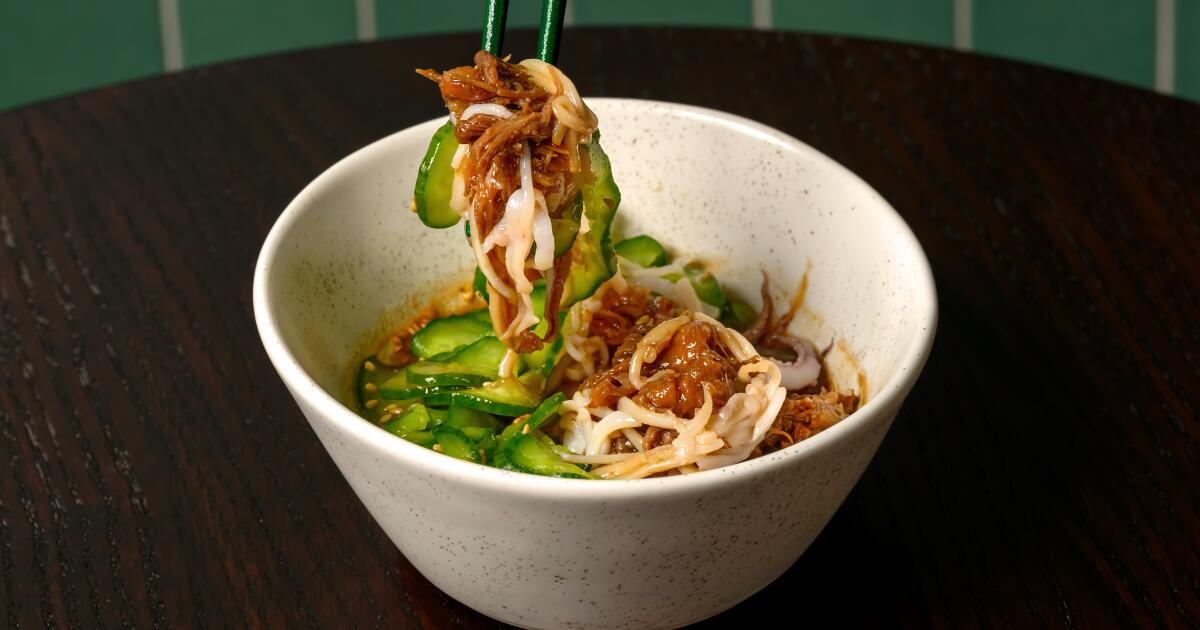Zhajiangmian was one of the first dishes my mother taught me how to make. I’d stand beside her in the kitchen, watching her stir fermented soybean paste into sizzling ground pork, the smell sharp, earthy and instantly familiar. A pot of noodles boiled nearby as I carefully julienned cucumbers, proud to contribute to one of my favorite comfort meals. When the ingredients were ready, we’d build our bowls with noodles, sauce and a handful of crisp veggies. Then came the best part — mixing it together until every noodle was slick with sauce. It wasn’t fancy, but it was fast, filling and always hit the spot.
According to Tian Yong, head chef of Bistro Na in Temple City, humble zhajiangmian may date back to the Qing Dynasty, when minced meat noodles became popular in Beijing for its affordability and ease of storage. Another origin story tells of an empress dowager who, fleeing an invasion, encountered a zhajiangmian-like dish in Xi’an.
However it came to be, zhajiangmian, or “fried sauce noodles,” is everyday comfort food in China and a staple of northern Chinese cuisine. “It carries cultural nostalgia and a sense of regional identity, particularly for Beijing natives,” says chef and cookbook author Katie Chin, founder of Wok Star Catering in Los Angeles. At its core, the dish is built on a simple foundation of wheat noodles (often thick, chewy and hand-pulled or knife-cut), ground pork and a deeply savory sauce made from doubanjiang, fermented soybean paste.
Like many regional Chinese dishes, zhajiangmian is fluid, shaped by geography, ingredients and personal taste. “It doesn’t just vary between regions of China — it even varies between households in different parts of Beijing,” Yong explains.
Chin uses several types of soybean paste in her zhajiangmian, each bringing its own personality to the bowl. Traditional Beijing-style relies on pungent yellow soybean paste for its salty, umami-rich depth. Tianjin-style leans on sweet bean sauce for a milder, more balanced flavor, while some versions use broad bean paste to add heat and complexity.
Then there’s the Korean-Chinese adaptation, jjajangmyeon, introduced to Korea by Chinese immigrants in the early 20th century. It swaps fermented soybean paste for chunjang, a Korean black bean paste that’s sweeter and less salty. “The dish is served over softer noodles and typically mixed together before eating, unlike the Chinese version where toppings are placed separately,” Chin says.
The vegetable toppings are essential to the dish’s character. “They can vary according to Beijing’s four seasons and traditional agricultural calendar,” says Yong. In spring, you might see spinach shoots, mung bean sprouts or radish greens; summer brings julienned cucumber, lotus root and edamame; fall offers carrots, garlic chives and bok choy; winter, Napa cabbage and wood ear mushrooms. While zhajiangmian is one of China’s most beloved noodle dishes, in the U.S., the spotlight tends to shine on familiar favorites like chow mein, lo mein or dan dan mian. But zhajiangmian has a deserved place alongside those staples in the canon of Chinese noodles.
I set out to find the best versions in Los Angeles and discovered dozens of interpretations. Some stayed true to tradition, others took creative liberties. But each bowl shared the same sense of comfort I remembered from my childhood — that salty, savory, soul-satisfying mix of noodles and sauce. Here are 11 of the best places to try zhajiangmian and jjajangmyeon in L.A.
